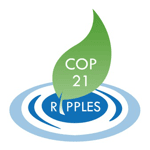The COP21 outcome represents an important new strategic context for EU climate policy, both at the international and at the EU level. The project COP21-RIPPLES aims at providing an analysis of the implications of this new context through an interdisciplinary approach. Such analysis requires a capacity to combine analysis of the adequacy of the outcome of COP21 and the evolution of the international climate regime complex; to analyse NDCs and deeper mitigation pathways; and to assess their socio-economic implications at multiple levels: Member State, EU, and globally.
General aims
The COP21 outcome represents an important new strategic context for EU climate policy, both at the international and at the EU level. The project COP21-RIPPLES aims at providing an analysis of the implications of this new context through an interdisciplinary approach. Such analysis is also urgent, given the timelines imposed by the Paris Agreement for a “facilitative dialogue” in 2018 with a view to creating the conditions for the revision of NDCs in 2020.
In order to address the context described above, this project has four objectives :
1) Assess the adequacy of the NDCs submitted at COP21 in light of the global temperature target of limiting warming to 2°C/1.5°C. Through the analysis of GHG scenarios and energy system scenarios, the project will pay particular attention to the concrete system changes induced by NDCs, and compare them with the changes required to meet the global temperature limit. The project will also analyse scenarios limiting warming to 1.5°C, and the impact of NDCs on other sectors, in particular land-use.
2) Assess the implications of NDCs and deeper mitigation pathways on other European socio-economic objectives. By integrating GHG and energy system scenarios into a range of different macro-economic, global energy system models and other quantified methodologies, the project will investigate implications for European socio-economic objectives related to innovation and technology deployment; trade and competiveness; investment, financial flows and economic growth (“green growth”); and global energy markets and energy security.
3) Assess the adequacy of the outcomes of COP21, and the implications and opportunities emerging from ongoing UNFCCC negotiations. The project will undertake a social sciences-based (in particular international law and international relations) assessment of the outcome of COP21.
4) Provide policy recommendations for EU climate policy and climate diplomacy.
CMCC Role
CMCC leads Task 3.2 on “International trade, industrial competitiveness, and low-carbon transformation in emissions-intensive industrial sectors and sectors supporting low carbon economies”, within WP3 “Realising Green Growth: Economic and Security dimensions of NDCs and deeper mitigation pathways”.
Expected results
This project aims to contribute robust scientific research into a number of important EU and international policy discussions.
1) Clarify the required actions and available pathways back to 2°C/1.5°C and the trajectories and strategies of major third countries and drive an ambitious revision of NDCs by 2020
2) Clarify the implications of the international context of NDC and 2°C/1.5°C trajectories in terms of EU socio-economic objectives
3) Contribute to the Development of the International Climate Regime
4) Providing Scientific Input into International Scientific Processes such as the IPCC and Enhancing Scientific Cooperation with Third Countries
Activity
1) Quantify the implications of the INDCs and 2°C/1.5°C mitigation pathways on international trade, industrial competitiveness, and low-carbon transformation in emission-intensive industrial sectors;
2) Investigate how domestic industrial policies, and green innovation interact with the INDCs and climate policy and affect carbon leakage, international trade, and industrial competitiveness;
3) Analyse opportunities that might arise for low carbon carbon technologies (renewables, energy efficiency, etc), examine which sectors have major innovation potential,
4) Examine the efficacy of strategies to address competitiveness concerns, and to facilitate low-carbon transformation in emission-intensive industrial sectors.
Partners
- IDDRI - Institut du Développement Durable et des Relations Internationales
- CMCC - Centro Euro-Mediterraneo sui Cambiamenti Climatici
- Fundacja Warszawski Instytut Studiów Ekonomicznych i Europejskich (WiseEuropa)
- ENEA - Agenzia nazionale per le nuove tecnologie, l'energia e lo sviluppo economico sostenibile
- Wupperthal Institute
- Bruegel
- CNRS - Centre National de la Recherche Scientifique
- IES-VUB - Free University Brussels /Institute for European Studies
- UCL - University College London
- COPPE-UFRJ - The Alberto Luiz Coimbra Institute for Graduate Studies and Research in Engineering, Federal University of Rio de Janeiro
- Climate Strategies
- UEA - University of East Anglia
- Climate Analytics
- Sofia University
- TU - Tsinghua University, Institute of Energy, Environment, and Economy
- Oxford University
- UCT - University of Cape Town
- UCAM - University of Cambridge


